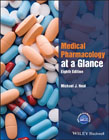
Medical Pharmacology at a Glance is recognised as an excellent starting point for pharmacology study. This international best–seller is the perfect companion for all medical and health students, providing an accessible, visual overview of pharmacology.This 8th edition has been extensively updated, especially in the areas of anaesthetics, drugs used in AIDs, cardiovascular drugs, drugs used in anxiety, depression and schizophrenia, urological drugs, drug metabolism, as well as practical concerns such as drug indications and side effects. Ideal for USMLE and pharmacology exam revision, Medical Pharmacology at a Glance features: The basic principles of drug action, interaction, absorption and excretion Chapters based on diseases or syndrome, for efficient clinical learning An emphasis on drug mechanisms References to the pathophysiology of disease, to aid understanding of drug choice and action Case studies with questions and full explanation of answers A companion website at www.ataglanceseries.com/pharmacology featuring online cases and flashcards INDICE: Preface .Acknowledgements .How to use this book .Further reading .How to use your textbook .About the companion website .1 Introduction: principles of drug action .2 Drug receptor interactions .3 Drug absorption, distribution and excretion .4 Drug metabolism .5 Local anaesthetics .6 Drugs acting at the neuromuscular junction .7 Autonomic nervous system .8 Autonomic drugs acting at cholinergic synapses .9 Drugs acting on the sympathetic system .10 Ocular pharmacology .11 Asthma, hay fever and anaphylaxis .12 Drugs acting on the gastrointestinal tract I: peptic ulcer .13 Drugs acting on the gastrointestinal tract II: motility and secretions .14 Drugs acting on the kidney: diuretics .15 Drugs used in hypertension .16 Drugs used in angina .17 Antiarrhythmic drugs .18 Drugs used in heart failure .19 Drugs used to affect blood coagulation .20 Lipid–lowering drugs .21 Agents used in anaemias .22 Central transmitter substances .23 General anaesthetics .24 Anxiolytics and hypnotics .25 Antiepileptic drugs .26 Drugs used in Parkinson s disease .27 Antipsychotic drugs (neuroleptics) .28 Drugs used in affective disorders: antidepressants .29 Opioid analgesic .30 Drugs used in nausea and vertigo (antiemetics) .31 Drug misuse and dependence .32 Non–steroidal anti–inflammatory drugs (NSAIDs) .33 Corticosteroids .34 Sex hormones and drugs .35 Thyroid and antithyroid drugs .36 Antidiabetic agents .37 Antibacterial drugs that inhibit nucleic acid synthesis: sulphonamides, trimethoprim, quinolones and .nitroimidazoles .38 Antibacterial drugs that inhibit cell wall synthesis: penicillins, cephalosporins and vancomycin .39 Antibacterial drugs that inhibit protein synthesis: aminoglycosides, tetracyclines, macrolides and chloramphenicol .40 Antifungal drugs .41 Antiviral drugs .42 Drugs acting on parasites I: helminths (worms) .43 Drugs acting on parasites II: protozoa .44 Drugs used in cancer .45 Immunosuppressants and antirheumatoid drugs .46 Poisoning .47 Adverse drug reactions .Case studies and questions .Answers .Index
- ISBN: 978-1-118-90240-0
- Editorial: Wiley–Blackwell
- Encuadernacion: Rústica
- Páginas: 120
- Fecha Publicación: 11/12/2015
- Nº Volúmenes: 1
- Idioma: Inglés
